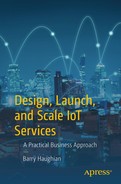The Internet revolution has resulted in a major disruption for many industries. It started with the development of the World Wide Web (the 1990s) and the evolved with the mobile Internet (the 2000s), forcing many to rethink their business models and embrace this disruptive technology. We are now heading to the third and potentially most disruptive phase of the Internet revolution—the Internet of Things. Objects from the real world will be modeled in the virtual world and connected via the Internet. This will result in humans and devices being connected at any time and from any place, and the implications are impossible to predict.
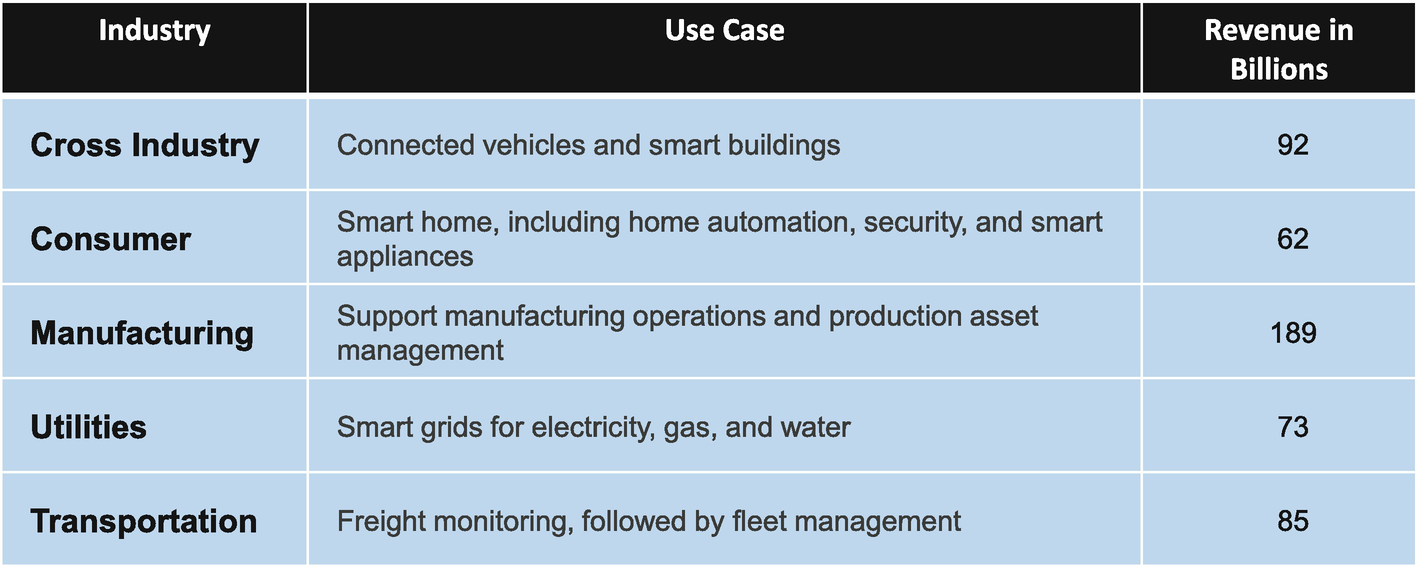
IoT industries (source: IDC Research 2018)
In this section, I will discuss some of the industry sectors and business opportunities available. The disruption to each industry vertical is unique and needs to be considered independently to understand the opportunities.
To be able to take advantage of the opportunities created by the IoT revolution, industry experts do not have to be experts in IoT. The reverse also applies, and cooperation will provide the greatest success. I usually start my IoT customer engagements by explaining that IoT can open new opportunities and business streams previously not available. I am not an expert in any specific industry vertical, but I can incorporate IoT into their business. In many cases, this will remove the business, operational and technology challenges permitting the customer to concentrate on their core business.
An example of this is illustrated by a major train company that requested an investigation to propose IoT solutions that could improve their customer experience and reduce costs. We had the preconceived idea that the key improvements would relate to the automation and scheduling of their train services to optimize fuel consumption or provide services to their end customers. After several workshops, we realized that the major issue they needed to solve was related to their operations organization. They needed an efficient IoT service to optimize their enormous operations workforce that maintained the network of railway tracks. This IoT service would require the deployment of thousands of sensors on railway tracks that could report faults to a central IoT system. It would classify the fault and automate workforce management for the maintenance engineers optimizing their workload and reduce costs.
I was questioned, “Could this be classified as an IoT service?” I responded that it didn’t matter if we called it IoT, but it ticked all my boxes. The service we defined consisted of large volumes of devices/sensors deployed and sending data over the Internet to solve a problem. The result allowed the company to improve operations, reduce costs, and focus on their core business: the train service.
Note that this same service could be repeated for other transport scenarios by simply modifying the upper layer of the IoT stack.
Industry Disruption
Internet users are estimated to grow to 6.5 billion in 2020, and the number of sensors is projected to grow to more than 50 billion in 2020. Whether we believe these numbers doesn’t really matter; it seems there will be a lot more devices than people using the Internet. This doesn’t necessarily imply a disruption for industries, but there are few factors that are contributing to the belief that we are on the cusp of something big.
The cost of implementing IoT services is reducing drastically. New tools are available to reduce the complexity (and cost) required to develop the services. The cost of producing hardware falls year after year as the capacity increases. This has resulted in a much broader range of industries being able to take advantage of the IoT revolution. The ability to offer services in a “pay-as-you-grow” model allows many second and third-tier companies to enter the IoT space. It has also resulted in a lot more opportunities for startups as it offers the possibility for companies with small investments to offer services within industry verticals that would have been previously out of reach. We can now see examples in the energy sector where IoT services are being offered that analyze energy consumption and take optimizing actions based on the results. This would have been unthinkable for a startup ten years ago.
Another positive disruption is that non-cooperating industries have the possibility to collaborate and offer new or improved services. If the IoT revolution is successful, it will open the possibility for new innovative businesses to create ecosystems that ultimately disrupt all industries. For example, traditional telecoms companies are moving into different sectors, hiring consultants to develop offerings in verticals that they previously didn’t consider as part of their business plans.
Almost all industry verticals are impacted, but I have selected just a few to illustrate the challenges and business opportunities available in each sector. For further reading on IoT verticals, see Ref. 16, “IoT Business News,” and Ref. 17, “RFID Journal.”2, 3
Smart City
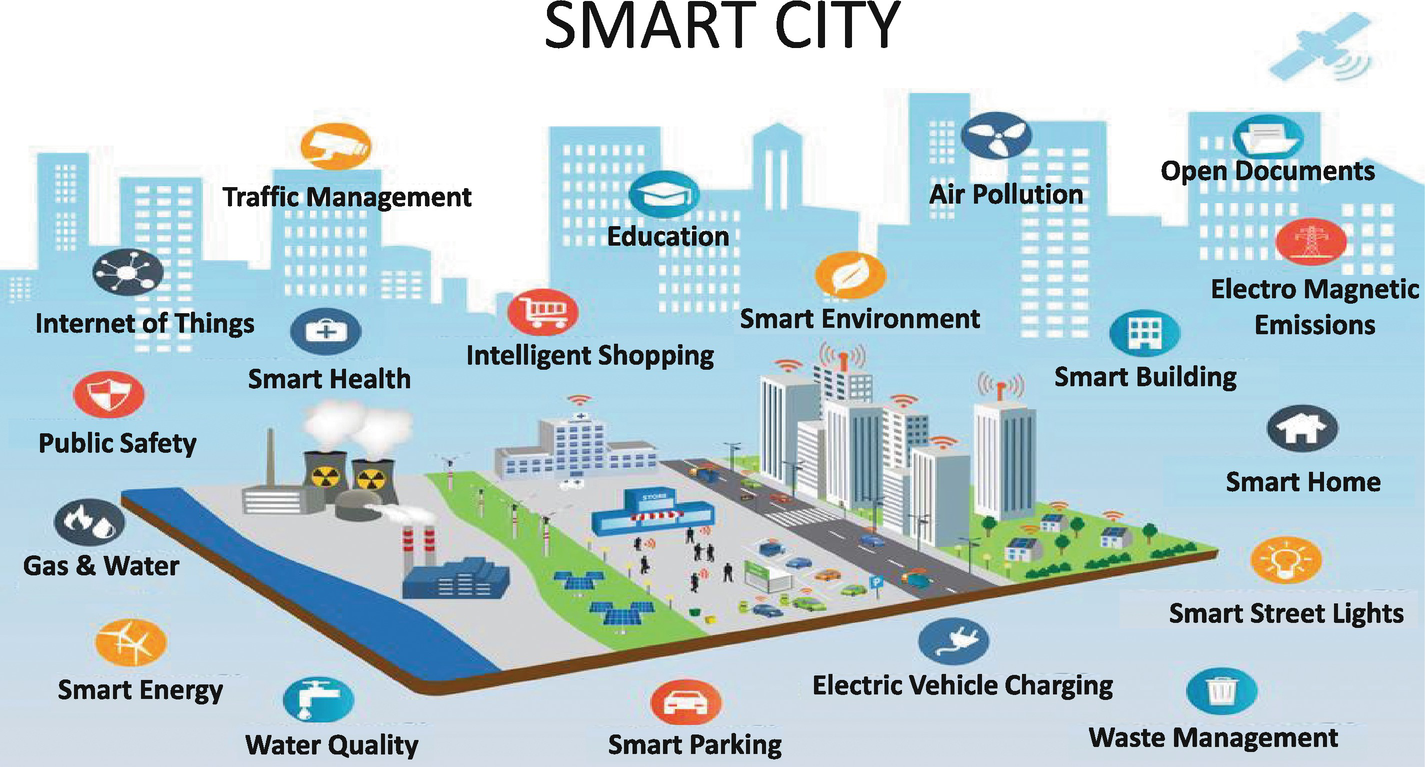
Smart city services
The following definition is generic but encompasses most of the aspects generally associated with smart cities: a smart city is an urban development vision to integrate information and communication technology (ICT) and Internet of Things technology in a secure fashion to manage a city’s assets.
The hype surrounding smart cities is considerable, and there are many diverse services being labeled as smart city offerings. Therefore, it can be beneficial for many IoT services to be described as smart city offerings to take advantage of the hype.
Often, smart cities are driven by government bodies (either central, regional, or city) that want to provide a better service to the citizens or increase efficiency in public services. Many public bodies employ independent bodies to oversee the tendering process for smart city contracts to ensure transparency and equal competition. This can have the knock-on effect of introducing long sales cycles for IoT service companies, and this needs to be considered in the sales process for public tenders.
As the smart city concept becomes more widespread, the definition of a smart city should consolidate into a common range of services. Already there have been some attempts to standardize the work related to smart cities. For example, the European Union in its funding for smart cities is suggesting compatibility with FIWARE as the reference architecture. FIWARE defines its mission as, “The objective of FIWARE is to facilitate a cost-effective creation and delivery of Future Internet applications and services in a variety of areas, including smart cities, sustainable transport, logistics, renewable energy, and environmental sustainability.” Compatibility with this architecture may prove useful for many services.
Spain smart city: Focused on tourism via the creation of an ecosystem that connects devices to travelers to improve the tourism experience. The devices transmit data to be used by tourists free of charge in apps and smart devices.
Romania smart city: Focused on residents, improving their day-to-day quality of life by implementing a free smart parking service to reduce city congestion.
Netherlands smart city: Focused on reducing CO2 emissions by implementing intelligent traffic systems to reduce traffic congestion. Vehicles and traffic lights communicate by advising when lights are about to change color, allowing drivers to optimize their velocity.
United States smart city: Focused on controlling the energy consumption required by the state. A smart street lighting service is the first of many new IoT services to reduce energy consumption.
In general, these services have one thing in common; they are free for residents (or users) of the smart city. The implication is that any potential service developed under a smart city umbrella may have to incorporate this business model. This does not imply that there isn’t a successful growable revenue stream for the service provider. They will be paid by the government body, but they can also investigate additional business streams by creating smart city ecosystems. For example, if residents are using a smart city app, there may be additional revenue opportunities for advertising to be sold. It should be noted that government contracts can often be quite complex, and the service provider should ensure that the T&C allow for the possibility to sell additional services.
The city of Santander in Spain is a good example of the implementation of a smart city where they are attempting to create an ecosystem powered by IoT service providers. They are promoting innovation by providing a central location to offer and promote IoT services that can become part of their smart city evolution.
The key to successful smart cities will be to create an ecosystem of companies that are exposing their data to be reused in other use cases. This will promote innovation and the development of new use cases. In most cases, the creation of the ecosystem will include a central portal that contains the services and resources for the future development and promotion of innovative use cases.
Smart Home
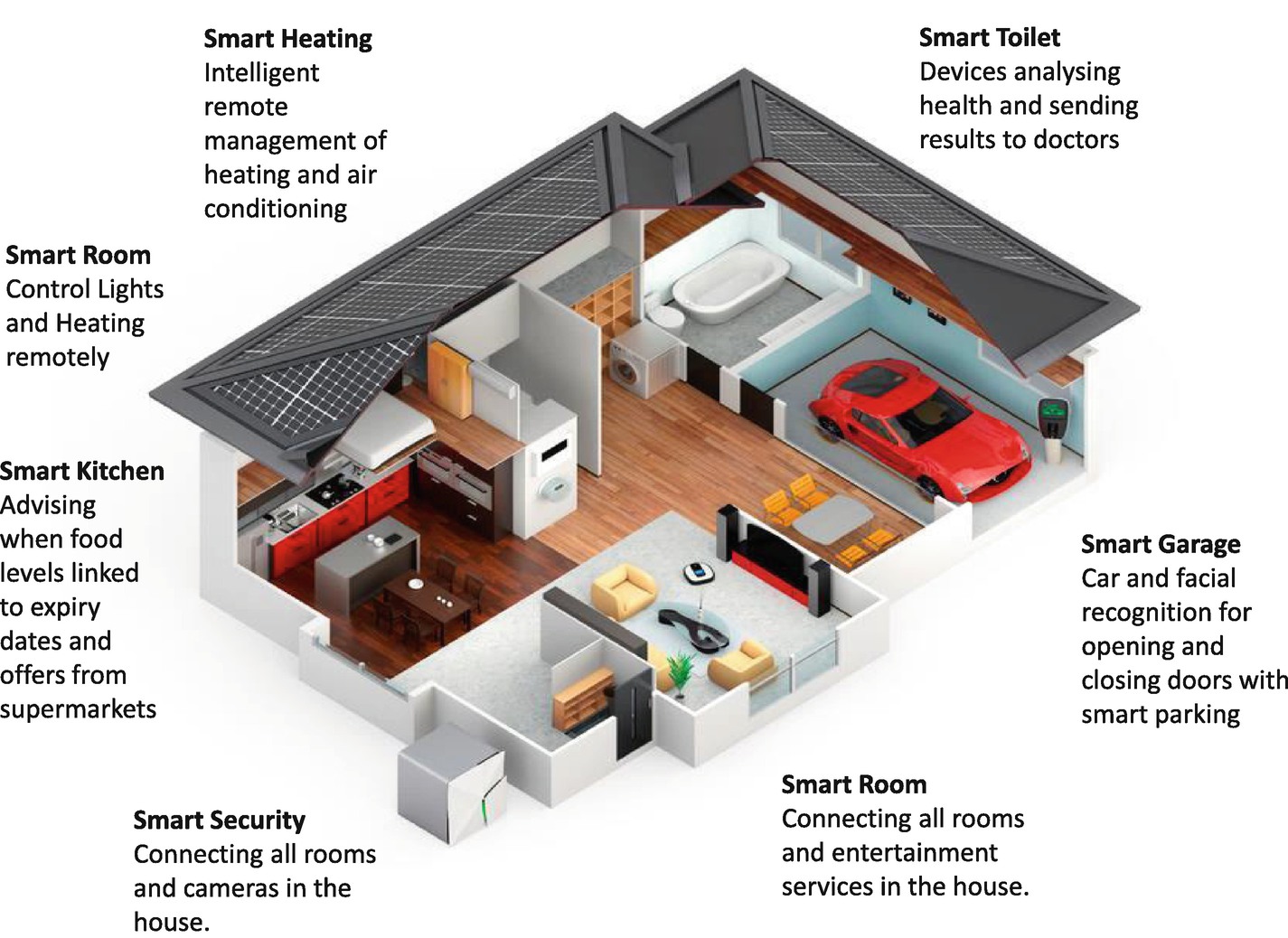
Smart homes
The main challenges for smart home services will be the development of distribution channels, the GTM strategies, and how to monetize on the service. The services require volumes, and the challenges are how to sell to many homes and how to deploy the service in a cost-efficient manner. The solution for many will be partnerships and selling through existing retailers already offering products for homes. The service should be designed to offer the ability for installation to be performed by the homeowners. Services that do not offer this ability may have issues with scaling and maintaining margins.
Although each smart home service will have unique challenges, a common issue that should be considered a high priority is security. All commercially deployed services will require a high level of security to prevent hacking or unauthorized access to home networks. A lot of the services are deployed with cameras in homes or devices that store confidential information. The current trends suggests that smart home services will incorporate a VPN or a common security key to identify the devices and users as part of the home network. The service owner will need to ensure the devices are configured correctly and that monitoring can be performed to report unauthorized access attempts.
Home security IoT services generally provide a low-cost entry for the service provider where the device is developed specifically for the use case performing activities such as remote monitoring, remote cameras, and intelligent locks. The majority of these use the cellular connectivity, which can provide a sufficient level of security and QoS that is often a mandatory requirement. One consideration often overlooked is communication. Many of the devices will use a form of low-range connectivity communicating with a central hub, but this connection may not have sufficient QoS. In scenarios where you cannot guarantee QoS measures must be taken to mitigate against failure. For example, if a sensor is not responding, the service must have the ability to detect the failure and recommend the appropriate action such as informing the homeowner that they should replace a battery.
There are many established home security service companies offering home monitoring services from a central security operations center (SOC). They are usually deployed with an AaS business model charging an installation fee and monthly subscriptions. New to the market are the systems that are installed by home owners, and monitoring is performed directly on their mobile phones (outsourcing operations to the home owner). This offers new opportunities to enter this lucrative market, and we can expect many of these services to follow the AaS model as it allows the investment to increase with sales. As discussed in Chapter 9, it creates a recurring revenue model and usually offers a closer customer relationship with an increased opportunity for up-sales.
There are many options for connectivity that should be considered during the design of smart home services such as the sensors being connected to a central console via Wi-Fi. This puts a prerequisite on the home owner to have sufficient coverage for all the sensors and manage issues that arise because of communication interference. It moves the boundary of the service toward the homeowner by placing the connectivity performance between sensors and the gateway outside the scope of the service. This should be reflected in the SLA, and the contract should be designed in a way that it is very clear on accountability and responsibility for the service performance. Although service providers may not be contractually responsible for the communication between nodes within the home, they should still expect to provide support for customers to ensure the service experience is acceptable.
Smart metering services are becoming widespread (in smart homes) because of new regulations in many countries requiring the deployment of smart meters. They usually consist of smart meters reporting on electricity, gas, or water consumption. The ownership and deployment of the devices is usually managed by a smart metering company that includes an app to enable the homeowners to monitor meters remotely. There are still many possibilities for implementing intelligent systems toward these services through APIs. For example, an automated service can activate appliances intelligently or inform homeowners of changes to the price of electricity or gas. There are additional challenges for new players in this market as these industries are not heavily regulated in terms of technology. This lack of industry standards may result in services being required to support many meter types and protocols, increasing costs considerably as they scale.
Smart appliances are readily available, but the use cases for each service need to be analyzed from a business perspective. I have already mentioned the use case of a fridge being able to communicate with an oven. While I have yet to understand the business value or any logical use for this it is not meant to suggest that there will not be innovative solutions related the kitchens including the smart management of communicating fridges or ovens. Smart plugs and smart lights are becoming widely available, and we can expect their deployment to accelerate. The most important aspect to consider while designing smart home services will be their usability. If the service requires complex configuration, it is unlikely to be successful. The goal should be that as soon as the device is turned on, it is automatically deployed and can be managed easily through mobile devices. Many smart home appliances will avail of Wi-Fi available in most homes and should be designed with sufficient range to communicate a central hub/gateway.
Transportation
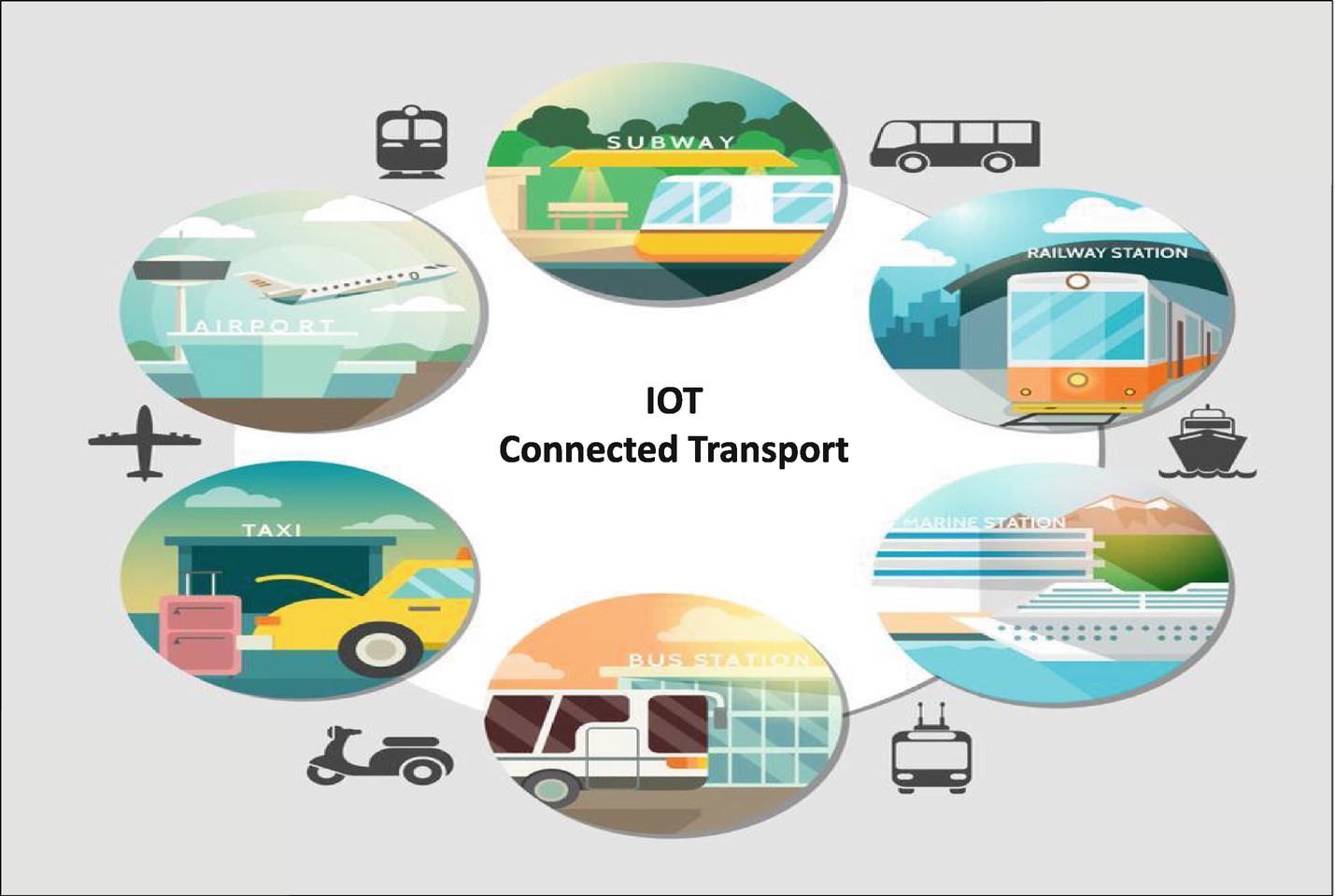
IoT transport services
Connected Vehicle Cloud
There are a substantial number of IoT transportation services already deployed such as autonomous driving, telematics, car infotainment, and roadside assistance. They are beginning to revolutionize our thinking regarding vehicles and the associated services. All major car manufacturers are investing in heavily connected vehicles, offering a wide range of services providing connectivity directly via devices embedded in the vehicle. The emergence of new players such as Tesla are muddying the boundaries between IT and traditional vehicle companies. The vast sums being invested by vehicle manufacturers means that it will be difficult for startups to become part of this industry vertical. They will need to carve out a niche market adding value to services already developed by the big players. Connectivity will almost certainly be cellular because of the QoS requirements and devices being mobile. Car manufacturers are forcing the reduction of connectivity costs and pushing the development of new services such as the introduction of multidomestic solutions with localized SIM capabilities. A key factor to be taken into consideration when developing a connected vehicle service is that the lifecycle of the connected device will most likely be the lifetime of the car, which is much longer than many other IoT devices.
Telematics data is currently available in most new vehicles, and it will be used by the car companies for predictive maintenance, components analysis, driver analysis, and more. At this stage, there are more questions than answers regarding the use of the data. This is a perfect environment for innovation for new IoT services. Already insurance companies are requesting access to this data to calculate insurance premiums. One of the questions to be answered that is particularly poignant for vehicle owners is, “Who has access to and owns the personal data being collected?” Security and privacy issues will be of primary concern, and there may be the possibility of owners selling the car data in the future. Regulation is far behind the innovation, and that is unlikely to change.
Connected Transport Cloud
I define connected transport services as the transport use cases that relate to the general traffic and not individual vehicles. There should be more possibilities for new services in this space than connected vehicles but with that comes more competition. There are no standard protocols for data collection as it can be provided by any number of sources, such as vehicles, traffic lights, garages, and regulatory bodies. The deployment of gateways to standardize how data is collected is likely to become fundamental for success in this space. One of the most common use cases being offered provides logistical services and real-time information for transportation companies to improve fleet efficiency. In the future, we will have the vehicles communicating in a mesh network to transmit real-time traffic data advising other vehicles in the fleet. There will be many opportunities for new services intelligently using this data.
As the devices are mobile, they may not always have the possibility to transmit because of coverage. Therefore, they should have the ability to store data and transmit it in real time or batch mode when communication is restored.
The security and legal implications of the vehicle data being transmitted will become paramount and hasn’t been given the attention it deserves. Services are already providing data analysis to report on the individual performance of drivers and fleet vehicles. In the future, this will have an increasing impact on driver performance bonuses and insurance premiums, enabling transport companies to improve their margins etc.
Energy
There is considerable disruption in the energy sector because of deregulation and the introduction of new renewable energy sources. The deployment of smart metering is being rolled out across the globe with smart grid services probably not being far behind. See Ref. 18, “IoT and analytics market for utilities expected to grow to $5.1bn in 2028.”4
During the assessment of an IoT smart metering service I was presented with a technical overview of the current service. The VP for operations illustrated a complex diagram detailing the architecture and communication flow from a hardware and software perspective. It was obvious that they would have no possibility to scale or optimize the current service because of the number different of device types, protocols and the complexity of the process flow. This is a quite common issue in the energy sector as it is not regulated and contains fragmented technology solutions. The solution to manage this complexity can be handled by the majority of IoT platforms, but with increased complexity comes increased cost. Gateways can provide part of the solution by implementing multiple protocols to handle many device types. The IoT middleware modules such as data/device management, asset management, and enterprise bus services can be used to automate the logistical processes. IoT smart metering services will make full use of IoT platform capabilities to automate and simplify service management if they are to be efficient and profitable.
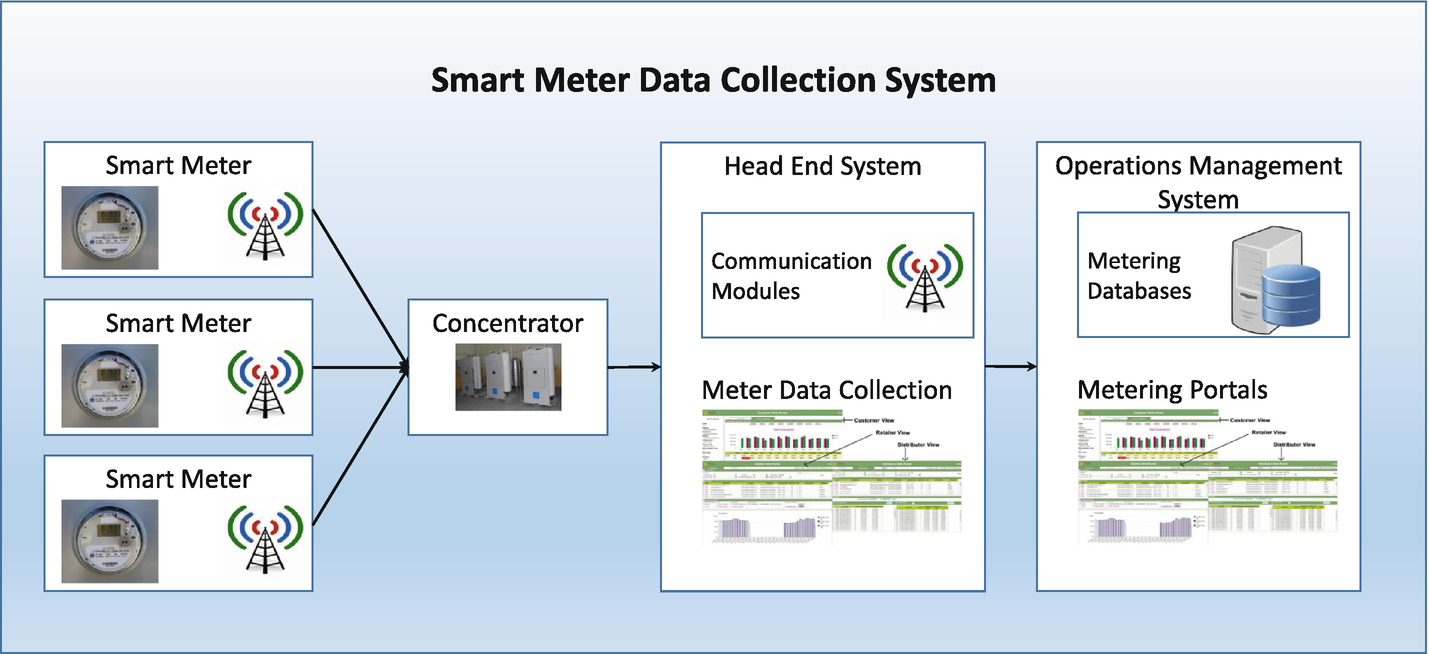
Smart metering architecture
If the architecture of the smart metering service does not include (enterprise) business processes and inventory management modules, it will be challenging to introduce efficiencies. Scaling will be an issue as operational costs are likely to increase in parallel with the device volumes.
Security has already been highlighted as an issue for energy providers, with hackers being able to gain access to electricity monitoring systems. Many of these incidents are reported as IoT security breaches with central IT systems being hacked. We can conclude that security is already fundamental for IoT services in this vertical, and it needs to be managed in all layers of the IoT stack (see Chapter 3 for more information).
Connectivity for meters has been implemented traditionally via PLC, and more recently cellular has become the norm. As with connected vehicle services, the lifecycle of smart metering devices can be expected to be quite long, about ten to fifteen years. Therefore, services should be designed with a view that the devices will have a long deployment period.
Manufacturing
Industry 4.0 promises to revolutionize manufacturing through the creation of smart factories. They will introduce automation and data exchange in manufacturing technologies including cyber-physical systems, IoT services, and cloud computing. Industry 4.0 and IoT are interconnected, and it will be fundamental to the success of IoT services. The production of IoT devices will require maximum automation, increased reliability, and reduced cost. The key to achieving these objectives will be via smart factories, with automation reducing human interaction from the device manufacturing process. See Ref. 19, “IoTone Accelerating the Industrial Internet of Things.”5
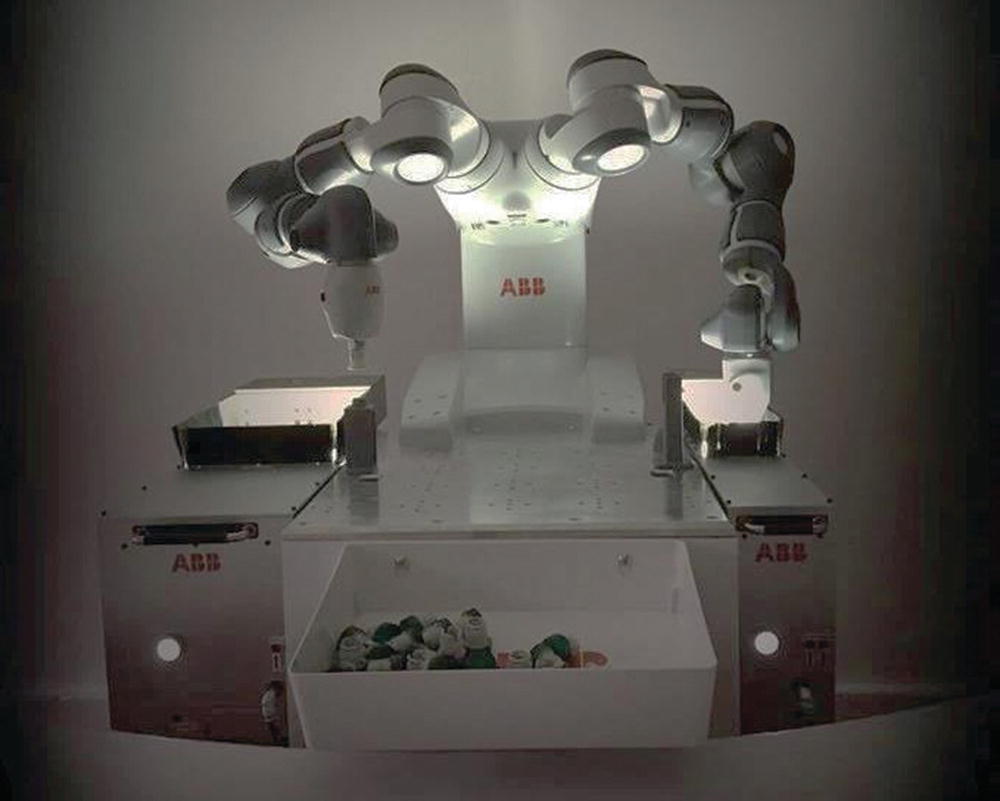
Collaborative robot
Although many service providers will outsource device production, there are still efficiencies that can be introduced (see Chapter 3). For example, the service owner should implement an automated process for ordering and producing devices. If a new batch of devices is required, it should trigger an automated production process that is activated when all components are available in stock. Ultimately, the goal is zero human interaction (interference). Many services allow existing customers to order new devices through a customer portal, offering increased service satisfaction and no additional operations costs as the service expands.
There are numerous opportunities for new IoT services in the manufacturing area mostly related to logistics and automation of manufacturing processes on the factory floor. Existing services should look for opportunities via ecosystems to understand whether their services can be reused in manufacturing (see Chapter 6).
Media
Many of the new revenue streams for the IoT in the media space will be associated with advertising towards the users of the deployed service. An IoT service that has a large deployment of devices to users has many opportunities for additional revenue streams because of the ecosystem created by the scale. For example, an Internet of Animals can have targeted advertising related to products to improve the current health of the animals.
Intelligent advertising has been available for quite some time, and it will be a key additional revenue stream for many IoT services. For example, an IoT service that has mobile devices deployed across a city could provide advertising related to shops and services as the devices approach specific areas.
Already we are seeing taxi services that are providing screens on the back of seats; the evolution of this service could be that once the destination is known, the taxi can implement targeted advertising from the shops on the route or at the destination.
Public Safety
The public sector is exploring how IoT can provide a higher level of service to its citizens. Often this can be considered as part of a smart city, but IoT public services generally require higher security levels than consumer-based smart city services.
This is another area where there has been a lot of hype, and it is necessary to understand the factors that enable IoT services to be used in public safety. IoT services will usually be delivered via the Internet; therefore, there may be no guaranteed quality of service, and that can be a minimum requirement for public safety services. This might sound alarming, but it can be handled if the service level agreement includes a clause to exempt the service provider if the interruption to service is outside their control. Therefore, the question needs to be asked, can IoT services be used for public safety services? The answer is yes in many scenarios. If the current service is improved by introducing IoT, then there is a value that will result in a revenue stream.
The analysis of the data can be key for public safety use cases. For example, several cities in Europe are performing trials with emergency services. If a call is received by an emergency service, they can be advised of the best route to reach their destination. More advanced trials route the emergency service, with traffic lights being activated to remain green for the emergency service route.

IoT public safety use cases
Health
The possibilities for IoT health services are endless; the most common are services such as remote patient monitoring or remote diagnosis. Almost every phone or smart wristband can monitor our health, which can become part of much bigger IoT services. One aspect that is still in its infancy is that of smart hospitals, where the IoT services are supporting the overall management of the hospitals. The IoT services will optimize and track hospital resources as with any smart building, increasing efficiency and reducing cost. We are likely to see 5G offering new possibilities of real-time medical services that can be deployed in hospitals or for in-home healthcare services.
The challenge for many services will be QoS, which is difficult for many services to guarantee (chemical analysis sensors can have a limited lifetime and questionable reliability). Remote patient monitoring has been implemented in many countries, and most would agree that while there are no 100 percent guarantees with the service, the patient is better off with it than without it. The key is to implement processes that take clear corrective actions in cases of service interruption such as device or communication failure. There also must be an agreement between the service provider and service receiver in case of failure. For example, many devices are monitoring the health of patients to report back data for automatic analysis. In the future if the device or communication fails to report back data the patient should have a backup procedure available. An alarm can be sent to advise the patient to go to a hospital to have manual readings performed or to have the device replaced.
In this chapter, we have seen some of the major industry verticals that are impacted by the IoT. The opportunities are endless, and each IoT service will have to find its niche market opportunity within the vertical. I usually suggest “no idea is a bad idea,” but the key message here is that the service should have the ability to adapt quickly as the service evolves and industry specific market conditions change.
